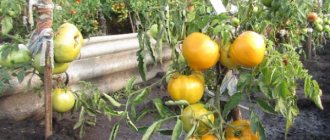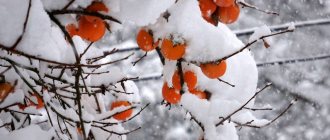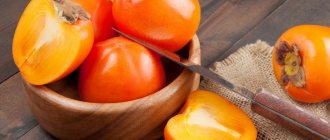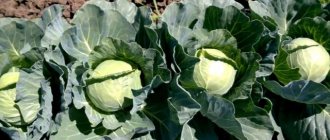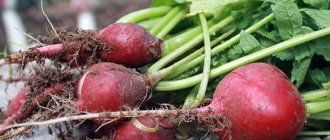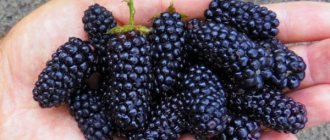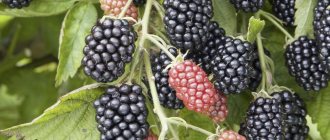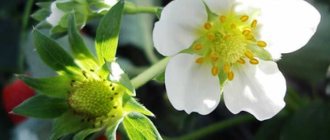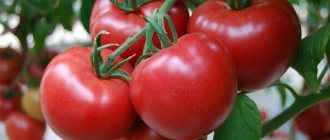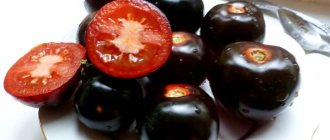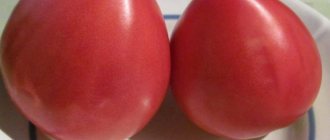Description and photo
- Definition. Virginia persimmon (or American persimmon) is a small tree with medium-sized brownish-orange fruits and sweet, tart flesh.
- Appearance. Persimmon Virginia trees are similar to apple trees and can grow up to 20 meters. The fruits are round, orange in color, and resemble a tomato in shape and size.
- Botanical description. Virgin persimmon is a deciduous tree with dark gray or brownish bark, up to 20 m in height. Lives up to 150 years.
The plant is dioecious. The flowers are unisexual and pollinated by insects or wind. It blooms from May to June, the harvest ripens in October-November. The leaves are large, alternate, oval-shaped, with a heart-shaped base and a pointed end, about 15 cm long. The persimmon fruit is a fleshy berry, with juicy pulp, up to 3-4 cm in length. diameter, fruit weight 70-150 g. The seeds have a thin skin and are flattened on the sides - there are from 3 to 10 pieces in the fruit. Light- and moisture-loving tree, but tolerates dry soil; frost-resistant, tolerates frosts down to -25°C – -30°C. The root system is deep taproot. Prefers acidic and neutral (pH 5-8) light soils. - Spreading. Persimmon Virginia is native to North America: widespread in Kansas and Oklahoma. It is cultivated in many European countries, mainly in the Mediterranean, as well as in Asia:
- China;
Japan;
- Indonesia;
- Philippines.
Persimmon has successfully acclimatized in Russia - thanks to the suitable climate, it is grown in the Caucasus in:
- Krasnodar region;
- Southern Stavropol region;
- Fergana Valley.
Cultivated in Armavir and Maykop, as well as Volgograd and Sochi.
Features of caring for Virginia persimmon
The main criteria for success are agricultural technology, freedom from diseases and pests. A prerequisite is preparation for wintering, such as: stopping watering 1-1.5 months before the end of the growing season so that the shoots ripen. Good ripening of wood is promoted by phosphorus and potassium fertilizers, which should be applied in higher doses in the second half of summer.
Particularly effective is foliar feeding with 0.5-1.5% 1-3-day aqueous extract of superphosphate with 0.5% potassium sulfate with the addition of potassium permanganate 0.02-0.05% or potassium iodide 0.02%. Spraying begins with lower concentrations at the end of summer, weekly, gradually increasing the concentration of the working solution to maximum values.
Persimmon plants are able to accumulate iodine in the fruit. If in coastal areas the absorption of iodine comes from the air saturated with it, then in continental areas the addition of potassium iodide to the solution for foliar feeding is more than desirable. There are different opinions on the issue of frost resistance of persimmons, moreover, the difference sometimes reaches 3 - 5 degrees.
a solution of 0.2% dimethyl sulfoxide, 0.05% glycerol, Mars (or Vympel) preparations. By the way, treatment with Vympel accelerates the ripening of fruits, increases sugar content, and increases their size. In areas with drying winter winds, you can try treating trees after leaf fall with solutions of latex or PVA glue in a dose of 30-50 ml per 10 liters of water.
Persimmons bear fruit on the current year's shoots; last year's buds (like grape buds) contain all the information for the future branch with leaves and flowers. Flowers will only come from well-executed buds, located at the end and middle of the future shoot. The key to a good harvest is to obtain strong annual growth.
Which in turn depends on the provision of trees with nutrients, water and pruning. Heavy pruning is used only when forming the crown. During the fruiting period, they limit themselves to thinning and removing damaged and drying branches. Only branches longer than 50 cm and branches with numerous short (less than 10 cm) shoots are shortened.
In addition, it should be taken into account that heavy pruning after laying the skeleton of the crown negatively affects the longevity of the trees. The vegetative bud is laid in September-October of the year preceding flowering; by the end of winter, the vegetative bud takes on a cone-shaped shape, two outer scales cover 2/3 of its length.
The two inner ones are densely pubescent. There are up to 18 rudimentary leaves. In early spring, the formation and development of flower buds begins in the axils of these rudimentary leaves. Please note: you can try to stimulate an increase in the number of flowers by treating the trees with an aqueous solution of caffeine; for this purpose you can use pharmaceutical tablets of caffeine-sodium benzoate.
Flowering occurs in May-June, less often - in July and lasts 1 - 1.5 months. The lifespan of a male flower is 1 - 2 days, they are small, 2 - 4 pieces in a bunch. Female flowers are larger in size, pitcher-shaped, four-petaled, pale green, solitary and capable of fertilization within 3 - 4 days.
The size of the fruit greatly depends on the growing conditions; for example, the fruits of Nikitskaya burgundy can weigh either 130 or 30 grams. The yield of different varieties is different; it depends on the formation, nutrition, and fertilization of flowers. At 4 years of age it is possible to obtain about 10 kg of fruit, at 10 years of age up to 200 kg, followed by a constant increase in yield.
When the harvest is abundant, chatalovka is used. When shoot growth decreases and fruiting stops, rejuvenating pruning has a good effect. In the year of such pruning, the trees do not produce a harvest, but the next year they bear fruit on a par with non-rejuvenated ones, and then the yield increases. It is recommended to keep the soil in the garden under black fallow and sow green manure in the fall, which is plowed in April-May next year or mowed and crushed into mulch.
When the garden is 8-10 years old, it is recommended to apply mineral fertilizers based on the active ingredient: nitrogen and phosphorus 1.5 kg, potassium 0.5 kg per hundred square meters. Pest and disease control is usually not carried out, since we have not observed any serious damage from them. Although in fairness it should be noted that persimmons can be affected by scab, gray mold, and Phomopsis, from which spraying twice (before and after flowering) with Bordeaux mixture or better with systemic drugs, at least Ridomil, is sufficient.
History of selection.
In America, cultivated varieties of Virginia Persimmon were bred - they are called “persimonnes”. At the State Nikitsky Botanical Garden in Crimea, breeder A.K. After the war, Pasenkov developed an interspecific hybrid of Eastern and Virginia Persimmon - “Rossiyanka”, with frost resistance down to -26°C.
A little later A.N. Kazas received the Nikitskaya Bordovaya variety, which showed higher frost resistance - down to -30°C. Among the new varieties of persimmon, large-fruited varieties stand out - “Mount Goverla” and “Roman-Kosh”, with frost resistance down to -20...-24°C.
Today in Russia and Ukraine the following varieties of persimmon are common:
- "Mid"
- "God's gift";
- "John Rick";
- "Belgorodye".
Favorable conditions for growing persimmons
How do persimmons grow at home? To grow a domesticated persimmon, it is advisable to create tropical conditions:
- Persimmons in a pot require diffused light; they are illuminated for 2-3 hours both in the spring and autumn seasons. Home culture does not like direct sunlight; on a clear day in summer, the window is covered with gauze.
- In the summer season, persimmon prefers fresh air, without drafts, in a shaded place.
- Watering a home tree is carried out in small doses, avoiding stagnation of water and dirt in the container.
- Spray the foliage every day.
- The tree sheds its leaves in the dormant phase and persists at t = – 15 °C. The plant is placed in the basement, the optimal temperature for storage is +5 ... -10 ° C, with regular moistening of the earthen clod.
- During the growing season, it is necessary to feed persimmons in moderate doses, replant or renew the top soil layer.
Comparative table of varieties
| Virgin (American) |
|
| Zenji-Maru (Chocolate) |
|
| Hiakume (Wren) |
|
| Hachia (Bull's heart) |
|
| Sharon (Apple) |
|
| Russian |
|
When choosing persimmons in the store, you need to focus on your taste preferences. If persimmons need to be transported somewhere or are planned to be stored, you need to select a variety with increased shelf life and transportability, with a harder skin, and choose slightly unripe fruits so that they ripen during storage.
Varietal features
Virginia persimmon belongs to the ebony family. Often, a second name is used for this variety - Virginia. It grows in certain areas of North America and is also found in the Mediterranean.
In Russia, it is grown mainly in the Caucasus, because according to its characteristics it is a typically southern tree. However, many gardeners from other regions are trying to plant this variety on their site. This does not always end successfully, and the Virgin persimmon bears fruit. If you stock up on the necessary information and patience, you can grow a wonderful tree in the temperate zone of the country.
According to the description, the Virginskaya persimmon tree has an average height. The growth of individual specimens exceeds 20 m - this depends on the fertility of the soil. The lifespan of some trees reaches 100 years or more.
The culture has dark bark. Some of the large leaves have pointed ends, the fruits resemble berries, and the pale flesh is very juicy. Pollination occurs by insects or even the wind. There are both monoecious and dioecious plants, flowering occurs in the summer. The fruits of the Virginskaya variety contain many useful substances:
Both small fruits and large specimens weighing up to 500 g ripen. The average diameter of the fruit is 5-6 cm. Their shape and number of seeds vary. Some fruits do not have seeds. Persimmons are processed for various dishes and are often used as a filling for confectionery products.
How to choose a ripe berry?
Sometimes store-bought persimmons “stay in the mouth” - this means that they were unripe. To choose ripe and sweet persimmons, you need to remember a few simple rules. The surface of the peel should be smooth and slightly shiny. Damaged skin with dark spots and stripes is a sign that the persimmon has already begun to deteriorate.
The color is bright and rich, but unripe fruits are also orange, so you need to look at other signs. The stalk and leaves are dry and dark. Touch it carefully - the persimmon should be soft to the touch, so you can eat it right away.
Advice
But if you suddenly bought unripe persimmons, then you can freeze them - after defrosting, they will get rid of the astringent taste, become softer and sweeter. To make persimmons ripen faster, they can be stored with apples or bananas.
Related materials:
Editor's Choice: January | persimmon | sandwich | oranges | Vitamins | glucose | blender | appetite | delicious flavors | sweet scents | orange flavor | vegetable oil | natural shades | taste | water | aroma | bananas | together | Red color | subtle aroma | smoothie
Articles
- The story of one dish: ratatouille March 19, 2013, 19:00
- Pineapple story April 13, 2014, 20:30
- Rhubarb story June 30, 2021, 18:00
Video
- Idylle by Guerlain. History of creation October 25, 2011, 11:03
- Clarins presents natural facial oils August 17, 2012, 10:30
- La Petite Robe Noire fragrance from Guerlain in a new version of eau de parfum April 11, 2013, 17:09
Chemical composition
Calorie content of Virgin Persimmon – 67 kcal per 100 g. Among all persimmon varieties, Virginskaya is in first place in terms of the amount of vitamins, macro- and microelements. It contains up to 44% sugar, mainly in the form of fructose and glucose.
Ripe persimmon contains: 25% sugars, 1.5% protein, 0.85% fat (daily intake). It also contains vitamins: A, B, C, E, PP, and useful substances - tannins, pectin, sodium, magnesium, zinc, iron, phosphorus, calcium.
Relevant products in the Online store:
Natura Siberica
MICELLAR SERIES Natural certified micellar Beauty water
from 627 rub.
Atelier Cologne
CLÉMENTINE CALIFORNIA Gift set with the sweet scent of summer
from 5,282 rub.
limited edition new
Alterna
Bamboo Smooth Weightless oil-spray for the care of fine hair
from RUB 2,788
SEPHORA COLLECTION
Good Skincare Triple Action Makeup Remover Micellar Water in Travel Size
from 254 rub.
exclusive
All goods
Benefits and harms
Benefit
- The shoots and leaves contain a lot of ascorbic acid and can be added to tea.
- Contains beta-carotene, which removes harmful substances from the body and improves the condition of the skin and vision.
- Vitamin A strengthens the eye muscles and helps normalize vision.
- Vitamin B regulates metabolism and calms the nervous system.
- Iron normalizes cardiac activity.
- Dietary fiber helps remove waste and toxins from the body.
- Persimmon is recommended for use for diseases of the cardiovascular system, hypertension and anemia.
- A diet rich in persimmon helps normalize lipid metabolism.
- Eating persimmon has a beneficial effect on the condition of the liver and bile ducts.
- Has a diuretic effect.
Harm
Eating unripe fruits can lead to acute intestinal obstruction due to the high tannin content.
How to grow?
Due to its increased frost resistance, Virginia persimmon is often used as a rootstock.
When to plant?
In the southern regions of Russia, it is recommended to plant Virginia persimmon in the fall, while the soil is still warm, so that the seedlings have time to take root. In more northern regions, planting is carried out in the spring, when the soil has warmed up to +14-15°C and the threat of frost has passed.
Landing
Seeds
Persimmons can be grown from seeds. To do this, they need to be cleared of pulp, washed thoroughly and soaked in water for 2-3 days. They can also be stratified in a wet state for 2-3 months at a temperature of 1°C to 5°C.
Seeds lose their viability from excessive heating, hypothermia or drying out. Seeds are planted in drained, moist soil with a large amount of humus to a depth of 1.5 cm. Persimmon grown from seeds begins to bear fruit at 6-7 years.
Seedlings
It is advisable to buy seedlings for planting in specialized stores. You need to choose seedlings with a well-developed root system and mature brownish wood. It is better to buy 2-3 seedlings - male and female varieties, or choose self-fertile ones.
Planting holes are prepared in advance, measuring about 40-60x40 cm. The distance between seedlings should be at least 5 m. It is not advisable to transplant persimmon from place to place, as it has weak tap roots. A day before planting, the seedling is watered with a rooting solution.
It is recommended to plant in a container or other container without a bottom. Dig a hole 2 times larger than this container, and add a layer of fertile soil to the bottom. A support stake is installed in the center of the pit. The roots of the seedling along with the container are placed in a hole and sprinkled with soil. Water again with rooting agent.
Attention!
The root collar should be at ground level or buried 4–6 cm. The soil around the seedling should be mulched.
Care
Persimmon seedlings must be watered abundantly, at least three times a month. It can survive short-term droughts. Virgin persimmon is resistant to frosts down to -30°C, but seedlings need to be covered for the winter - to save them from frost, rodents and hares.
In the first year, you need to form the crown according to a sparse tiered system - this reduces the height of the tree, which will be convenient for harvesting. In the first year, seedlings do not need to be fertilized. At the end of summer, you can apply potassium fertilizers for better ripening of shoots.
Trees need to be fully fertilized from the moment they bear fruit – potassium fertilizers are recommended. In Russia, Virginia persimmon is practically not affected by diseases.
To protect against scab and gray rot, seedlings are pollinated with 1% Bordeaux mixture three times a season. You can get rid of Japanese pseudothyroidism with the help of Preparation 30.
Harvesting and storage
Persimmon fruits are carefully picked by hand so as not to damage the delicate peel. The harvest is stored in baskets and boxes at a temperature of 0..-1°C and air humidity of 80-90% - in this case the fruits are stored for up to 3 months.
Another storage method is freezing in refrigerators. At the same time, the fruits become sweeter and their astringency goes away; The shelf life is extended to 6 months. Another way to store persimmons is drying.
Early varieties of persimmon: description of varieties
Thanks to modern breeding, many varieties of persimmon have been developed - about 300 species.
For our country, only a few hybrids that have good resistance to adverse weather conditions and the ability to produce good yields are of greatest interest. Oriental, Virginia and Caucasian persimmons have these qualities.
The most popular, productive and winter-hardy include several varieties of persimmon (species name Diospyros).
The giant tree, reaching 30 m in height, is highly decorative. It mainly grows in the Caucasus, which is why this species is called Caucasian.
The plant is frost-resistant, can withstand from -23 to -25 °C. The fruits are small, weighing 20-25 g. The taste is tart and sweet. After ripening, the light skin acquires a dark purple color.
The seeds are small, each fruit contains no more than 4 pieces.
Caucasian persimmon is highly decorative
The Caucasian persimmon variety is an excellent rootstock for cultivated forms.
The resulting seedlings have a fibrous, branched system.
They easily tolerate transplantation, are resistant to drought and adverse weather conditions, and do not form root suckers.
For the first time, Virginia persimmon (Virginiana) appeared in North America. The plants are tall - 18-23 m in height.
Frost resistance is high - up to -35 ° C.
Therefore, seedlings of this variety are used to obtain frost-resistant species intended for cultivation in the northern zone.
This deciduous tree begins to wake up with stable heat when the outside temperature reaches 20 C°. Typically this period falls in the last ten days of April or the first ten days of May.
Therefore, the species is especially valued in the regions of the northern zone. Due to the long period of winter dormancy, the plant vegetates after all frosts have passed.
This eliminates the risk of buds and shoots freezing during prolonged thaws.
The first fruiting of Virginia persimmon occurs when shoots of the fourth or fifth order are present.
The varieties grafted on this plant are demanding of moisture, tolerate the transplantation procedure less well, develop slowly, produce a meager harvest and are less durable.
The Vergina variety has one cultivated variety, which in America is called persimone.
This plant first appeared in China.
In Latin, eastern persimmon sounds like “Diosporis kaki”, which means “Divine Fire” (“food of the Gods”).
This variety also has other names - kinglet, Japanese persimmon and Chinese persimmon. In Israel they call her Sharon - an artificially bred hybrid.
The description of culture identifies the following characteristics:
- deciduous, medium-sized tree, reaching 8 m, sometimes 12 m in height;
- in appearance, the eastern persimmon is very similar to an apple tree (the crown is spherical, spreading, densely covered with lush, green foliage, which acquires a burgundy color by autumn;
- blooms in late May - early June with four-petalled yellow flowers;
- the flowers are bisexual, grow on different trees, so pollination occurs due to insects;
- depending on the region, fruiting occurs at the end of October or beginning of November;
- fruits with a bright orange skin, sweet in taste with a slight bitterness, the pulp is seedless or contains a small amount of seeds;
- With good care, the fruits reach impressive sizes and weigh from 60 to 500 g.
Persimmon Sharon (Eastern) gives large fruits with good care
Oriental persimmon, like other hybrid frost-resistant varieties, will give a good and high-quality harvest if its flowers are fertilized on time. To ensure this process, for every 8 trees with female flowers, 1 male tree is planted, which will become a pollinator for them.
In the absence of a pollinator, you can fertilize the flowers manually - first the flowers, then the ovaries are treated with a gibberellin solution.
The concentration of the substance should be selected in accordance with the instructions on the packaging.
In the absence of proper moisture, treatment of persimmons with gibberellin is mandatory.
When choosing a place to plant eastern persimmons, you should be guided by the following factors:
- This plant grows best on loamy or sandy soil with deep groundwater - about 1 m from the ground surface. This requirement is due to the peculiarity of the plant’s root system, which reaches 0.6-0.7 m deep. The soil should be slightly acidic and well fertilized.
- The optimal feeding area for low-growing varieties is 25 m2, for vigorous specimens - about 63 m2.
- Oriental persimmon should be planted on the south side of the site. It is also important to provide protection from winds, which contribute to frostbite of the tree in winter and drying out in summer.
- This is a light-loving crop, so it is planted in the sun. In a shaded area, persimmons develop poorly and produce a small harvest of deformed fruits.
In the regions of the Middle Zone and Siberia, this crop is grown as a creeping or wall plant.
It is planted on the south side of a heated building.
Such a plant has every chance of survival, growth and annual fruiting.
Considering that oriental persimmon is an exotic fruit, getting varietal seedlings will not be so easy. You can only purchase real planting material from the manufacturer.
When buying young trees from resellers or on a spontaneous market, you risk being deceived: at best, you will get a wild one, at worst, a completely different plant.
Even those seedlings that are presented at exhibitions do not always live up to their name and, when planted in the Northern zone, freeze out during the first wintering.
You should buy planting material with bare roots in the fall. The less time has passed since it was dug up, the better.
Literally a couple of hours after digging, the roots wither and the plant may die.
Seedlings with dead fibrous roots and healthy taproots are suitable for planting. Roots also react poorly to excess moisture.
In the south, eastern persimmon seedlings are planted in mid or late October. In the Northern zone and in the regions of the Central zone, planting is recommended in the spring, after the heat has stabilized.
Landing rules
Before the procedure, the area is sprinkled with rotted manure - 1 bucket per 1 m2 of area, then the soil is dug up and leveled.
The depth of the hole should correspond to the dimensions of the root system. A 10 cm layer of crushed stone is poured onto the bottom, followed by the same layer of garden soil. A stake is driven in, which will serve as a support for the tree.
Planting is done so that the root collar is 4-5 cm higher above the soil surface.
To avoid breakage and injury to the fibrous roots, the seedling is placed against the wall of the pit and thin and fragile roots are spread over its surface. The roots are covered with earth, lightly trampled and covered with peat, fallen leaves or rotted manure.
Before the onset of the first frost, the plants are covered with a cardboard box or wooden box, and additionally covered with spruce branches.
All types of persimmon, including oriental persimmon, are fast-growing crops. With good care and growing conditions, eastern persimmon begins to bear fruit already in the 3rd year.
But, according to experienced gardeners, you should not get carried away with the first harvest, but direct all your efforts to forming the crown of the tree.
The quality and quantity of future harvests will depend on this.
Pruning rules
For this crop, the formation of a modified leader crown would be preferable. With this method, a strong, medium-sized tree with a moderately thick crown will be formed.
When forming, maintain an interval of 30-40 cm between the skeletal branches. From 4 to 6 branches are left on the tree.
Read more: Self-fertile plum variety, low-growing, winter-hardy
Trimming is carried out in several stages:
- The next year after planting, before the start of sap flow, the young trunk of the seedling is trimmed at a height of 90 cm. Of the branches extending from the trunk, only two branches are left for growth. One is cut to the height of the trunk - about 0.5 m, the other is 30 cm higher from the first. Next year, a new continuation shoot will appear from the bud on the central conductor. The remaining sprouts are removed or the buds are pinched in advance to prevent their growth.
- In early spring of next year, the central branch is shortened at a height of 1.5 m. The side shoots of last year are trimmed, leaving a length of 40-50 cm. So the semi-skeletal branches will be located as close as possible to the conductor.
- In the summer, the development of two oppositely located branches is stimulated. They should be located perpendicular to the two lower skeletal branches. As a result of such pruning, the first tier is formed, after which the central conductor is transferred to the side branch.
Features of care
Subject to agrotechnical rules and regular preventive measures against diseases and pests, every gardener, even a beginner, can grow Japanese persimmon.
Young kaki persimmon seedlings are watered at least 2 times a month. Mature trees - once a month, taking into account precipitation. Overmoistening of the soil can lead to massive shedding of unripe fruits.
Feeding
If the plant is planted in nutritious soil, then the first fertilizing is applied no earlier than 3 years after planting.
Early ripening fruits can be consumed immediately after being removed from the branches. As a rule, such varieties ripen at the beginning of autumn, feel great and produce high yields in the South Coast, Sochi and the subtropics of the Caucasus. By applying some secrets of agricultural technology, namely by providing protection during the cold season, early varieties of persimmon can be grown much further north.
Gosho Gaki
Persimmon, the tree of which is not distinguished by its tall growth and lush crown. The variety was bred in Japan, where it was first widely cultivated. For pollination and harvesting, simultaneous planting of other varieties of persimmon is required. The dark orange fruits have a thick skin, which is an advantage for transportation.
Their weight is about 200 g, their shape is round-conical. The juicy pulp with a pleasant taste has a brownish-orange tone when seeds are present and yellowish-orange when they are absent. The harvest is stable and amounts to 75 kg per tree. Gosho Gaki is resistant to frost and infections. The fruits can be stored for several months in special cellars.
